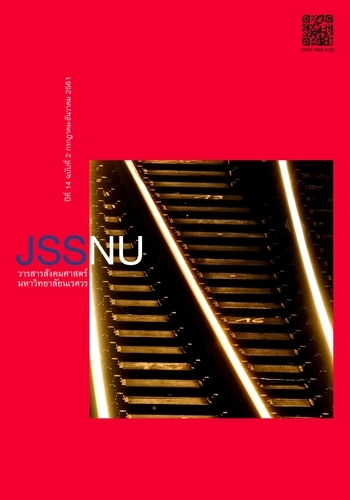ใครควรเป็นผู้เป่านกหวีดในการบริหารจัดการภัยพิบัติอุทกภัยในประเทศไทย: กรณีการบริหารจัดการภัยพิบัติอุทกภัยจังหวัดสกลนคร พ.ศ.2560
Main Article Content
บทคัดย่อ
ผู้เป่านกหวีด (whistleblower) ในการบริหารจัดการภัยพิบัติอุทกภัยมีความสำคัญกับ การสร้างประสิทธิผลในการบริหารจัดการเพราะทำหน้าที่ตรวจสอบเตือนภัยอันตรายให้แก่สังคม การเตือนภัยทั่วถึงและรวดเร็วย่อมนำไปสู่โอกาสในลดความสญูเสียและความเสี่ยงจากภัยพิบัติได้มากขึ้น ดังนั้นขีดความสามารถในการเตือนภัยจึงสัมพันธ์กับการกำหนดบทบาทของตัวแสดงในการบริหาร จัดการกับสถานการณ์ คำถามที่ว่า “ใครควรเป็นผู้เป่านกหวีดในการบริหารจัดการภัยพิบัติอุทกภัย ในประเทศไทย?” เป็นคำถามที่จุดประกายขึ้นจากการกรณีของการบริหารจัดการภัยพิบัติอุทกภัย จังหวัดสกลนคร พ.ศ.2560 อันสืบเนื่องจากนโยบายการบริหารจัดการภัยพิบัติของรัฐไทยทั้งในรูป ของกฎหมายและแผนการบริหารจัดการต่างให้อำนาจกับตัวแสดงที่เป็นกลไกของกระทรวงมหาดไทย ในการทำหน้าที่เป่านกหวีดและการสร้างตัวแทนจัดตั้งเพื่อร่วมกับรัฐในการสนับสนุนการแจ้งข้อมูลของ สถานการณ์ ลักษณะและรูปแบบปฏิสัมพันธ์ของตัวแสดงที่เข้ามามีส่วนร่วมเรียกได้ว่าเป็น “พันธมิตร ราชการ (Bureaucrat partnership)” ซึ่งเมื่อตัวแสดงเผชิญกับสถานการณ์ภัยพิบัติอุทกภัยจริงใน พื้นที่กลับเกิดข้อจำกัดในการขับเคลื่อนการบริหารจัดการด้วยเงื่อนไขแบบระบบราชการทำให้เกิด ความล่าช้าและความเสียหายกับประชาชนเป็นวงกว้างอีกทั้งยังเป็นระบบที่ขาดการตรวจสอบถ่วง ดุลข้อมูลสนับสนุนการตัดสินใจในสถานการณ์ การแจ้งเตือนภัยจึงกลายเป็นข้อถกเถียงที่สะท้อนถึง ความสำคัญของตัวแสดงภาคสังคมในฐานะ “พันธมิตรพลเมือง (Citizen partnership)” ที่เข้ามา ช่วยพัฒนาประสิทธิภาพเชิงสถาบันการบริหารจัดการภัยพิบัติของรัฐไทย ซึ่งนัยยะของการเปิดโอกาส ให้พันธมิตรพลเมืองเกิดขึ้นในฐานะผู้เป่านกหวีดไม่เพียงแต่สนับสนุนประสิทธิภาพในการเปิดเผย สถานการณ์เท่านั้นแต่ยังหมายความถึงการพัฒนาการผสมผสานตรรกะของการแจ้งเตือนภัยในการ สื่อสารกันระหว่างรัฐกับสังคมให้แน่นแฟ้น อีกทั้งยังเป็นส่วนช่วยในการพัฒนาความเป็นประชาธิปไตย ของภาคประชาชนผ่านการรักษาผลประโยชน์สาธารณะร่วมกันในการบริหารจัดการภัยพิบัติอุทกภัย
Downloads
Article Details
เอกสารอ้างอิง
กรมป้องกันและบรรเทาสาธารณภัย. สถิติสถานการณ์สาธารณภัย ประจำปี 2558.
กรุงเทพธุรกิจ. 2559, 29 กรกฎาคม. “ใครทำสกลฯจมน้ำ.” Url:
กิตตินันท์ นาคทอง. 2560. “ศัพท์น้ำท่วม ‘เอาอยู่’ ‘น้ำรอการระบาย’ ถึง ‘กัดเซาะสันเขื่อน’.” Url:
ข่าวสดออนไลน์. 2559, 28 กรกฎาคม. “รวมภาพวิกฤตน้ำท่วม ‘สกลนคร’ จมบาดาลทั้งเมือง ประชาชน
เดือดร้อนหนักเร่งอพยพ.” Url:
แนวหน้า. 2560, 1 สิงหาคม. Url:
ประชาชาติธุรกิจออนไลน์. 2560, 29 กรกฎาคม. “‘ปลอดประสพ’ ชี้สกลเสียหายหนัก เหตุไร้การเเจ้งเตือน
น้ำท่วม ถามรัฐปล่อยให้เกิดได้อย่างไร.” Url:
พระราชบัญญัติป้องกันและบรรเทาสาธารณภัย พ.ศ.2550.
แผนการป้องกันและบรรเทาสาธารณภัยแห่งชาติ พ.ศ.2558.
มติชน. 2560, 30 กรกฎาคม. “อิทธิฤทธิ์ ‘เซินกา’ ‘อีสาน’ ระทมจมน้ำ.” ปีที่ 40 ฉบับที่ 14385.
มติชนออนไลน์. 2560, 29 กรกฎาคม. “มทภ.2 บินด่วน สั่งช่วยชาวสกลนคร-ผู้ว่าฯพบปัญหาเครื่องสูบน้ำ
ทน. สกล ชำรุด ต้องระดมเข้ามาเพิ่ม.” Url:
มหาวิทยาลัยเกษตรศาสตร์ วิทยาเขตเฉลิมพระเกียรติ จังหวัดสกลนคร. 2560. “หนองหาร: ลักษณะทาง
กายภาพ.” Url:
B8%81%E0%B8%B2%E0%B8%A2%E0%B8%A0%E0%B8%B2%E0%B8%9E/>.
รัฐธรรมนูญแห่งราชอาณาจักรไทย พ.ศ.2560.
รัฐบาลไทย. 2560, 31 กรกฎาคม. Url:
ระเบียบกระทรวงมหาดไทยว่าด้วยกิจการอาสาสมัครป้องกันภัยฝ่ายพลเรือน พ.ศ.2553.
ระเบียบกระทรวงมหาดไทยว่าด้วยหลักเกณฑ์การแต่งตั้งและการปฏิบัติหน้าที่ของเจ้าพนักงานป้องกันและ
บรรเทาสาธารณภัย พ.ศ.2553.
วลัยลักษณ์ ทรงศิริ. 2559. “พอเพียงเพื่อแผ่นดินเกิด: เปลี่ยน ‘หนองหาร’ เปลี่ยนชีวิตและสังคมคนสกลนคร.”
Url:
ศิริรักษ์ สิงหเสม. 2554. “เครือข่ายนโยบายและการจัดการภัยพิบัติจากอุทกภัย: กรณีศึกษาเฉพาะจังหวัด
นครราชสีมาและจังหวัดชัยภูมิ.” วิทยานิพนธ์ปริญญามหาบัณฑิต, สาขาบริหารรัฐกิจ, คณะรัฐศาสตร์,
มหาวิทยาลัยธรรมศาสตร์.
ศิริรักษ์ สิงหเสม. 2560ก. “หรือความล่าช้าจะนำไปสู่ความไม่เป็นธรรม ข้อสังเกตการบริหารจัดการภัยพิบัติ
สกลนคร พ.ศ.2560.” Url:
ศิริรักษ์ สิงหเสม. 2560ข. “การวิเคราะห์เชิงสถาบันว่าด้วยการบริหารจัดการภัยพิบัติอุทกภัยของประเทศไทย.”
วิทยานิพนธ์ปริญญาดุษฎีบัณฑิต, สาขารัฐศาสตร์, จุฬาลงกรณ์มาหวิทยาลัย.
สำนักข่าวกรมประชาสัมพันธ์. 2560, 29 กรกฎาคม. “นายกรัฐมนตรี กำชับทุกจังหวัดในพื้นที่เสี่ยงภัยน้ำ
ท่วมทำงานเชิงรุกต่อเนื่อง เน้นเข้าถึงและช่วยเหลือผู้ประสบภัยระดับครัวเรือน พร้อมทบทวนปรับปรุง
การเตือนภัยให้มีประสิทธิภาพ แนะประชาชนอย่าหลงเชื่อข่าวลือ.” Url:
สำนักงานก่อสร้างชลประทานขนาดใหญ่ที่ 3. “โครงการพัฒนาลุ่มน้ำก่ำอันเนื่องมาจากพระราชดำริ จ.สกลนคร.”
Url:
สำนักงานสภาพัฒนาเศรษฐกิจและสังคมแห่งชาติ. “ตารางแสดงสถานการณ์อุทกภัยของประเทศไทย พ.ศ.
2532-2558.” Url:
Translated Thai reference
Bangkok Biznews. 2017, July 29. “Who make Sakon Nakhon Drowning.” Url: < www.bangkokbiznews.
com/news/detail/766681>.
Department of Disaster Prevention and Mitigation. “Emergency Situation Report of the year
2015.”
Disaster Prevention and Mitigation Act, 2550 B.E.
Interior Ministerial Rule on Civil Defense Volunteer, 2010.
Interior Ministerial Rule on Criteria, Appointment and Operation of Disaster Prevention,
Mitigation Staff, 2010.
Khaosod Online. 2017, July 28. “Flood Crisis Picture of ‘Sakon Nakhon’: City is Drown, People
is Troubled, Horridly Evacuated.” Url: < www.khaosod.co.th/special-stories/news_455740>.
Matichon Newspaper. 2017, July 30. “Son Ca Impact Makes the Northeast Region Drown.”
Year 40 Vol.14385.
Matichon Online. 2017, July 29. “The 2nd Army Area Commander Takes a Plane and Orders
to Help the Sakon Nakhon People; Governor Found Pump Out of Order, Pump then Must
Be Increased.” Url:
Naewna. 2017, August 1. Url:
Naktong, K. 2017. “Flood Keywords ‘Aw-Yu’ ‘Nam Ror Kan Rabai’ to ‘Kud-Sur-Sun-Kearn’.”
Url:
National News Bureau of Thailand. 2017, July 29. “Prime Minister Orders All Risk-Provinces
Be Proactive, Try to Help Flood Victims, Update Alarm Measures, and Warn People to
Reject Gossip.” Url:
Office of the National Economic and Social Development. “Statistic of Thailand flood situation
1989– 2015.” Url:
Prachachat Online. 2017, July 29. “‘Mr.Plodprasop Suraswadi’ Pointed that Sakon Nakhon
was Ruin because Lack of Flood Warning; Why Government Let It Happen?” Url:
Royal Thai Government. 2017, July 31. Url:
Songsiri, W. 2016. “Suffice is for Motherland: Changing ‘Nong Han,’ Changing Life and the
Sakon Nakhon Society.” Url:
Sinhasema, S. 2011. “Disaster Policy and Management Network: A Case Study of Flood
in Nakon Ratchasima and Chaiyaphum Provinces.” MA thesis, Public Administration,
Faculty of Political Science, Thammasat University.
Sinhasema, S. 2017a. “Institutional Analysis of Flood Disaster Management of Thailand,
2010-2011.” PhD Thesis, Faculty of Political Science, Chulalongkorn University.
Sinhasema, S. 2017b. “Will Delay Lead to Injustice? An Observation on the Sakon Nakhon
Disaster Management in 2017.” Url:
Thai Constitution, 2017.
Third Regional Irrigation Office. “The Royal-Initiated Kam River Basin Development Project,
Sakon Nakhon Province.” Url:
เอกสารภาษาต่างประเทศ
Blaikie, P., et al. 2014. At Risk: Natural Hazards, People’s Vulnerability and Disasters.
London and New York: Routledge.
Bowman, J.S., & J.P. West. 2014. Public Service Ethics: Individual and Institutional Responsibilities.
Washington, DC: CQ Press.
Cox III, R.W., S. Buck & B. Morgan. 2015. Public Administration in Theory and Practice.
London and New York: Routledge.
Denhardt, J.V., & R.B. Denhardt. 2007. The New Public Service: Serving, Not steering.
London: M.E. Sharpe.
Dunn, W. 2008. Public policy analysis: An introduction. Forth Edition. Upper Saddle River,
NJ: Pearson/Prentice Hall.
Durant, R. 2014. Why Public Service Matters: Public Managers, Public Policy, and Democracy.
New York: Palgrave Macmillan.
Etkin, D. 2014. Disaster Theory: An Interdisciplinary Approach to Concepts and Causes.
XXXX: Butterworth-Heinemann.
Goldman, D.E., and Rosenbloom, D.H. 2000. Whistleblower,” pp. 428-435. In Defining Public
Administration: Selections from the International Encyclopedia of Public Policy and
Administration, eds. J.M. Shafritz Jr. Boulder, CO: Westview Press.
Henik, E. 2015. “Understanding Whistle-Blowing: A Set-Theoretic Approach.” Journal of
Business Research, 68(2): 442-450.
Lonescu, R. 2015. “Whistleblowing and Disaster Risk Reduction,” pp.50-63. In Developments
in Whistleblowing Research, eds. D. Lewis & W. Vandekerckhove. London: International
Whistleblowing Research Network.
Ostrom, E. 1990. Governing the Commons: The Evolution of Institutions for Collective Action:
Political Economy of Institutions and Decisions. Cambridge: Cambridge University Press.
Pittroff, E. 2014. “Whistle-Blowing Systems and Legitimacy Theory: A Study of the Motivation
to Implement Whistle-Blowing Systems in German Organizations.” Journal of Business
Ethics, 124(3): 399-412.
Rhodes, R.A.W. 1997. Understanding Governance: Policy Networks, Governance, Reflexivity,
and Accountability. Berkshire: Open University Press.
Rosenbloom David, H., & R.S. Kravchuk. 2005. Public Administration: Understanding Management,
Politics, and Law in the Public Sector. Boston: McGraw-Hill.
Vinten, G. 1995. “The Whistleblowers’ Charter.” Executive Development, 8(2): 25-28.


